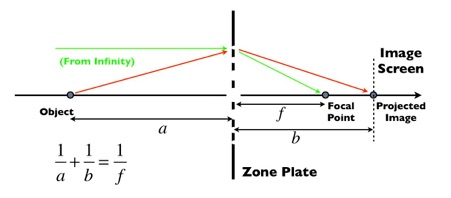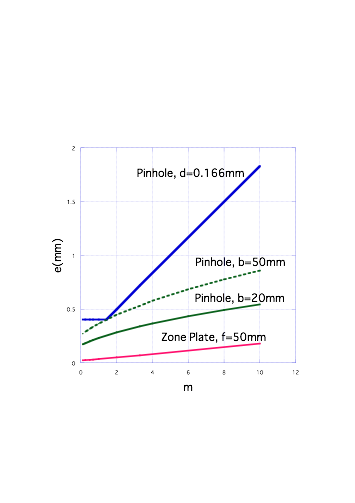Atelier Bonryu(E)
zone plate photography


Atelier Bonryu(E)
zone plate photography






Laboratory: Zone Plate Photography
Taking Zone Plate Photographs
- Macro-Photography by a Zone Plate (1)-


Macro-Photography: Usually, “macro-photography” means the photography to take a photograph with an image size on a sensor or a film larger than about a half or the same of an object size. For this purpose the lens of a camera should come close to the object and, therefore, the word “macro-photography” is often used synonymously as a word “close-up photography”. But exactly these are different and the latter includes photography with lower magnification factor. In the case of a camera with a lens by making the distance from an object to the lens (a) short the distance from the lens to the image plane (b) should be made increased. Much the same is true on the case of a zone plate (the formula of image formation, Fig.1). To take a photograph by a lens camera a macro lens is usually used for the macro-photography, as a variable range of distance within which one can focus the camera is limited for each interchangeable lens.

Figure 1
The formula of image formation
Magnification: The magnification (lateral magnification) factor of an image is expressed as m=B/A, where A and B are the sizes of the object and the image (Fig. 2). For a single thin lens (or a pinhole or a zone plate) the magnification factor m can be replaced by b/a (Fig.2). By decreasing the distance a from the object to the lens, therefore, the distance b from the lens to the image increases and the magnification factor also increases.

Figure 2
Magnification of the image
Macro-photography by a pinhole camera: When one take a photograph by using a pinhole camera a size of a projected image of a point light source becomes larger than the size of the pinhole. If one brings the camera closer to the object to attain a higher magnification factor the size of the image of the point light source becomes larger accordingly and the resolution becomes deteriorated. It may be, therefore, very difficult even if it is not impossible to take a photograph with high magnification factor by using a pinhole camera.

Figure 3
The light intensity distribution of an image of a point light source on the image sensor. The zone plate is a Gabor type with a focal length f=50 mm, the zone number N=29 for the wavelength of 550 nm. The red, green, blue, and magenta lines denote the cases of magnification factor of m=2, 1.0, 0.5, and 0.11, respectively.
Figure 4
Dependences of resolution on the magnification factor m for a zone plate (red: f=50mm, number of zones=29) and pinholes (blue: the size is same as the center circle of the above zone plate, green: the distance b to the image is kept constant). We define the resolution e as the radius of the image of the point light source.




Table 1
Relations among the magnification factor (m), and the distances from a zone plate to an object (a) and the image sensor (b).
Examples of zone plate macrophotography: Following pictures are macro-photographs of wild flowers including very small ones such as a Persian speedwell (diameter: about 8 mm) and a starwort (diameter: about 5 mm), taken at close range by using a Gabor type zone plate with the focal length of 50 mm and the zone number of 29 designed for the wavelength of 550 nm. As both the distances from the zone plate to objects (a) and the image sensor (b) are 100 mm, the magnification factor is about unity. The used DSLR camera is an Olympus E-300 which is a four-thirds format camera and the sensor size is 17.3 mm x 13 mm. It should be noted that even thin streak patterns on the petals of the Persian speedwell can be seen on the photograph.



